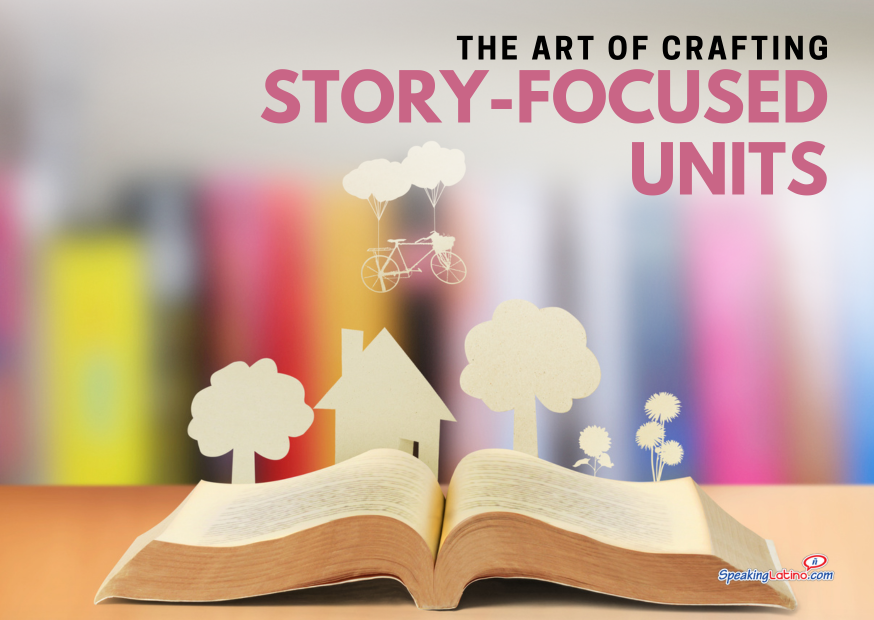
The content of this article is based on the presentation, Developing Story-Focused Units to Enhance Student Success by Michelle Rojas, which was part of the World Language Teacher Summit.
Leveraging the Transformative Potential of Stories in Language Education
Language acquisition is a complex and multifaceted process that demands innovative and engaging approaches to maximize students’ success. An effective strategy for fostering language proficiency is the development of story-focused units, where the central narrative becomes the cornerstone of a comprehensive and immersive learning experience. In this article you will explore insights on curating content that captivates students and propels language acquisition to new heights through the power of storytelling.
Understanding the Why of Story-Focused units
At the heart of the story-focused unit lies a fundamental shift in the educator’s perspective. Advocating for self-identification as content curators, emphasis is placed on the pivotal role of educators in simplifying language and making content accessible to students, regardless of their proficiency level. By recognizing the immense capacity of students to comprehend and engage with diverse information, educators empower them to navigate complex material effectively and foster a love for the language in the process. This shift in mindset enables educators to transcend limitations previously imposed by perceived language barriers, opening new vistas of understanding and engagement for students.The concept of backward planning emerges as a vital piece of the puzzle in crafting story-focused units. Stress is placed on the importance of establishing clear learning objectives before embarking on unit development, fostering a more cohesive and purposeful learning experience. By delineating targeted goals and outcomes, educators ensure that the entire learning journey is crafted with the destination in mind, creating a learning trajectory that is purposeful, impactful, and ultimately conducive to optimal student growth. This approach helps educators sidestep the pitfalls of fragmented learning experiences and construct a streamlined, goal-oriented progression that resonates with students’ needs and aspirations.Furthermore, the significance of incorporating all modes of communication into the learning experience is underscored. Beyond conventional reading and writing practices, educators are encouraged to infuse listening and nonverbal communication into the learning repertoire. By weaving a tapestry of communication modes, educators create a rich learning environment that resonates with students’ diverse learning styles and nurtures holistic language proficiency. This multifaceted approach diversifies the learning experience and stimulates students’ cognitive processes, thereby deepening their language acquisition and comprehension abilities.
Crafting Story-Focused Units
The process of building a story-focused unit involves an artful amalgamation of creativity, intentionality, and pedagogical finesse. The initial step in this journey entails the careful curation of a captivating resource, such as a video or a song, which serves as the nucleus of the unit. Educators are encouraged to select resources that resonate with students on a personal level, fostering relevance and igniting their enthusiasm for the learning material. Drawing on authentic and relatable content cultivates an immersive learning experience that resonates with students’ experiences, aspirations, and passions. Choosing resources that encapsulate thematic resonance empowers students to engage with learning material on a deeply personal and intrinsic level, creating a learning journey that is not just pedagogically sound but profoundly impactful and meaningful.Once the central resource is chosen, the process of distilling a theme from this material becomes pivotal. This theme serves as the guiding light that illuminates the learning journey, shaping all subsequent activities and engagements. Emphasizing the importance of personalizing the theme to reflect students’ lives and experiences, educators create an invaluable sense of relevance and resonance that propels student investment and enthusiasm. Infusing the learning material with the personal fabric of students’ lives cultivates an emotionally resonant and captivating learning journey that transcends conventional learning experiences.Setting clear and measurable goals for student achievement at the culmination of the unit emerges as a crucial component of crafting story-focused units. Articulating explicit student outcomes allows educators to optimize the learning journey towards a targeted objective, ensuring that students traverse a trajectory that is both impactful and purposeful. This imbues the learning journey with a sense of tangible progression, cultivating clarity and intentionality that fosters both student and educator investment in the learning process.The development of the unit entails an intricate orchestration of diverse activities, all calibrated to create a rich and immersive learning experience. Emphasizing the importance of introducing new vocabulary in context, integrating Total Physical Response (TPR) for kinesthetic learning, and creating a myriad of activities – from picture talks to comprehension checks – educators foster comprehensive language acquisition. This multilayered approach synthesizes diverse learning experiences to create a rich tapestry of language learning that resonates with students’ diverse learning styles and abilities.Key to crafting story-focused units is the infusion of nonverbal communication and movement into the learning experience. Integrating images, gestures, and movement connects students with the learning material on a profoundly experiential level, fostering engagement and comprehension. This multifaceted approach reflects a deep understanding of students’ diverse learning styles and abilities, creating a learning journey that is both enriching and inclusive.

Integrating images, gestures, and movement connects students with the learning material
A Lesson Example for a Story-Focused Unit
An illuminating example of an approach to developing a story-focused unit is offered through a short animated video centered on the theme of kindness. This real-world application provides insight into the practical realization of the concepts under discussion. By sharing a step-by-step process for creating a unit, valuable insights into turning pedagogical principles into tangible, impactful learning experiences are provided.From personalizing the theme to crafting clear student objectives, the nuts and bolts of developing a compelling story-focused unit are illustrated. A detailed outline, replete with diverse activities, underscores the richness and diversity of the learning experience crafted. It is this multifaceted approach that resonates profoundly with educators seeking to transform their teaching practices and create rich, immersive learning journeys for their students.
Leveraging Engaging Resources
In the presentation, exploration of diverse platforms and resources to foster an engaging and enriching learning experience is advocated for. From YouTube and Instagram to podcasts and educational blogs, the wealth of resources available to educators desiring to craft rich and impactful story-focused units is underscored. These platforms are highlighted as treasure troves of captivating content and teaching ideas, enabling educators to infuse their learning journeys with diverse and engaging materials.Drawing inspiration from platforms such as The Comprehensible Classroom, educators can access a wealth of activities tailored for language learning. This invaluable resource empowers educators by providing a diverse array of activities to enrich and enliven their language teaching, fostering a profoundly impactful and immersive learning journey.Moreover, educators are implored to be creative and to take measured risks when exploring new teaching ideas. By experimenting with new activities and resources, educators can infuse their teaching practice with innovation and creativity, creating an enriching and impactful learning experience for their students. The approach of taking calculated risks fosters a spirit of pedagogical innovation and experimentation, propelling educators towards a deeper and more impactful teaching practice.Additionally, the importance of finding content and resources that personally resonate with each educator is emphasized. By finding passion and relevance in the teaching material, educators can imbue their teaching practice with a profound sense of enthusiasm and passion, ultimately creating an immersive and engaging learning experience for their students. The fusion of personal passion and relatable content fosters an emotionally resonant and impactful learning journey that transcends conventional teaching paradigms.
FAQs about Story-Focused Units
How can story-focused units enhance student success?
Story-focused units can significantly enhance student success in several ways. Firstly, stories provide context-rich language input, which is essential for language acquisition. When students are exposed to language in context, they are more likely to understand and retain the language. This is because stories provide a meaningful and engaging way to learn new vocabulary, grammar, and cultural concepts. Secondly, stories can make language learning more enjoyable and engaging for students. When students are interested in the content, they are more likely to be motivated to learn and participate in class. This can lead to increased student engagement, participation, and ultimately, success in language acquisition. Thirdly, stories can help students develop their critical thinking and analytical skills. By analyzing the characters, plot, and themes of a story, students can develop their ability to think critically and make connections between different concepts. This can help them become more effective communicators and problem-solvers in the target language. Finally, stories can help students develop their cultural understanding and empathy. By exposing students to stories from different cultures, they can gain a deeper understanding of the perspectives, values, and beliefs of others. This can help them become more culturally competent and empathetic individuals, which is essential in today’s globalized world. Overall, story-focused units can enhance student success by providing context-rich language input, increasing student engagement and motivation, developing critical thinking and analytical skills, and promoting cultural understanding and empathy.
What are strategies for creating engaging stories in the classroom that I can use?
Creating engaging stories in the classroom involves a combination of thoughtful planning, creativity, and a focus on student relevance and interest. Here are some strategies for creating engaging stories in the classroom:
- Select Compelling Content: Choose stories, videos, songs, or other content that resonate with the interests and experiences of your students. Compelling content captures attention and creates a strong foundation for engagement.
- Personalize the Theme: Make the theme of the story personally relevant to your students’ lives. Connect the content to their experiences, values, and aspirations to make the story more meaningful and engaging.
- Set Clear Learning Goals: Define clear learning objectives for the story-focused unit. Determine what you want students to accomplish by the end of the unit and align the activities with these goals.
- Integrate Multimodal Elements: Incorporate a variety of activities such as Total Physical Response (TPR), visual aids, and interactive discussions to engage different learning styles and reinforce comprehension.
- Encourage Student Participation: Create opportunities for students to actively engage with the story through discussions, role-plays, creative projects, and collaborative activities. This fosters a sense of ownership and investment in the story.
- Extend the Story: Provide opportunities for students to extend the story through creative writing, art projects, or multimedia presentations. This allows them to explore the story in depth and express their understanding in diverse ways.
- Foster Critical Thinking: Encourage students to analyze the characters, plot, and themes of the story, promoting critical thinking and deeper engagement with the content.
- Incorporate Cultural Elements: Integrate stories from diverse cultures to promote cultural understanding and empathy among students. This can broaden their perspectives and enrich their learning experience.

Provide opportunities for students to extend the story through creative writing, art projects, or multimedia presentations.
By implementing these strategies, educators can create engaging stories that captivate students’ interest, promote active participation, and facilitate meaningful learning experiences in the classroom.
Can you recommend any additional resources for developing story-focused units?
Here are some additional resources that can be valuable for developing story-focused units in the classroom:
- YouTube: Utilize YouTube to discover a wide range of videos, songs, and short animated clips that can serve as engaging storytelling resources. These visual and auditory materials can enhance language learning and cultural understanding.
- Podcasts: Explore language learning podcasts and educational podcasts that feature storytelling, cultural insights, and engaging content suitable for classroom use. Podcasts can provide authentic language input and diverse perspectives.
- Social Media Platforms: Engage with language educators and content creators on platforms like Instagram, where teachers share classroom activities, resources, and insights. Following educators and educational accounts can provide inspiration and practical ideas for story-focused units.
- Professional Development Workshops and Conferences: Attend workshops, webinars, and conferences focused on language teaching and storytelling. These events often feature experienced educators sharing innovative approaches and resources for creating engaging story-focused units.
- Educational Literature: Explore books, articles, and academic journals related to language teaching, storytelling, and curriculum development. Educational literature can offer theoretical frameworks, practical strategies, and evidence-based practices for integrating stories into language instruction.
By leveraging these resources, educators can access a diverse array of materials, ideas, and best practices to enhance their ability to develop compelling and effective story-focused units for language learning.
A transformative paradigm shift in language education
Crafting story-focused units represents a transformative paradigm shift in language education. By leveraging the power of storytelling, educators can create an immersive and profoundly impactful learning experience that resonates with students on a deeply personal and intrinsic level. These insights serve as a rich and invaluable resource for educators seeking to transform their teaching practice and create immersive and engaging learning journeys for their students.Through intentional planning, personalized themes, and a plethora of engaging activities, educators can harness the power of storytelling to create a dynamic learning environment that bolsters students’ language acquisition, confidence, and overall success. By infusing their teaching practice with creativity, intentionality, and a profound sense of passion, educators can transform the learning journey into a rich and immersive experience that resonates with their students on a deeply personal and impactful level.